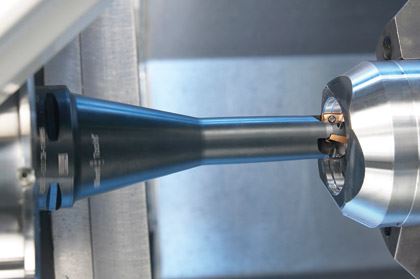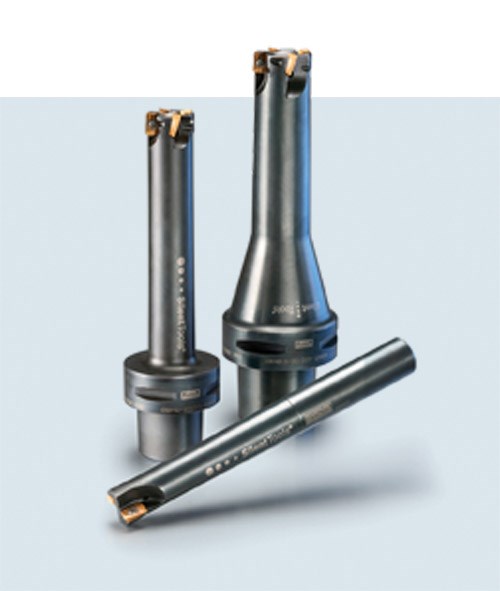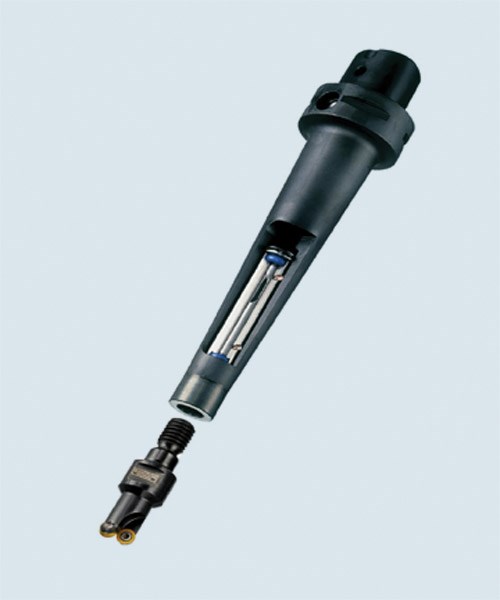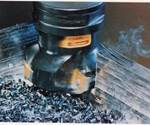Run Silent, Run Aggressive
Reap the benefits of using vibration dampening tools in your roughing operations.
Share
Vibration dampening tools—or silent tools as they are sometimes referred to—have been around for quite a while. Mold and die shops incorporate such tools to eliminate vibration issues associated with the long slender tools needed to machine the deep and narrow cavities of molds and dies.
Most shops apply silent tools to finish cut operations for generating smooth mold and die surfaces that require little, if any, secondary benchworking. But what these shops may not realize is that they can gain significant benefits by also using silent tools for roughing operations.
Silent tools, in particular dampened adapters, allow mold and die shops to run rough machining operations at faster cutter speeds and feeds, and take depths-of-cut that are frequently three times deeper than those possible with a comparable solid steel extended tooling assembly.
Additionally, today’s dampened adapters can work at much longer tool lengths and apply to wider ranges of materials—including stainless steels and titanium—compared to standard extended tooling assemblies.
When tools vibrate, they make noise, which is where the term silent tools originated. Dampened adapters counteract tool vibrations with passive internal systems that vibrate at different amplitudes than those being generated at the cutting edge of the tool.
Dampened adapters are an interface between machine tool spindles and cutting tool tips. The dampened adapter and cutting tool could be a one-piece design with the cutting tool integrated into the adapter, or it could be a system where cutting tools mount to the end of the adapter and are interchangeable.
Hollowed out chambers at the front of dampened adapters house what is known as the damper. Dampers are cylindrical-shaped heavy metal slugs surrounded by and floating in oil within the chamber. They have rubber grommets attached at each end, which in turn, are attached to springs attached to the edges of the chamber.
As standard tools start to cut, they begin to vibrate at particular amplitudes, and shops basically deal with them by reducing speeds and feeds. On the other hand, when these vibrations reach the dampening mechanism of a dampened adapter, the damper begins to move up and down vibrating at an opposite amplitude. This motion occurs in milliseconds and counteracts the vibration amplitude to completely eliminate any negative affects on workpiece surfaces.
Dampening mechanisms in silent tooling are passive systems that react to vibrations to control them. This is unlike active systems that involve the introduction of external mechanical or electrical forces/vibrations that help cancel out those generated by a cutting tool. Active systems are not internal and would involve some type of outside device.
Mold and die shops not using dampened adapters must build tools out to needed lengths. But to achieve fine surface finishes, these tools have to run at incredibly light cutting data, dramatically prolonging finishing operations and overall part cycle times.
It is recommended that shops already using or considering dampened adapters should match adapter to cutting tool. Specific tooling manufacturers design their adapters to run with their cutting tools. And while some shops will mix and match, the best possible cutting performance results from pairing adapter and tools from the same manufacturer.
In addition to mold and die milling applications, dampened adapters can be used for internal turning, boring and drilling. As with milling, these products work on overhangs beyond the limitation of solid steel and solid carbide shanks. They are easy to operate and are very flexible due to the wide variety of back-end and front-end couplings available.
Related Content
Considerations for Mold Base Material Selection
Choosing the right material can greatly affect the profitability and cost of your application.
Read MoreLeading Mold Manufacturers Share Best Practices for Improving Efficiency
Precise Tooling Solutions, X-Cell Tool and Mold, M&M Tool and Mold, Ameritech Die & Mold, and Cavalier Tool & Manufacturing, sit down for a fast-paced Q&A focused on strategies for improving efficiencies across their operations.
Read MoreICYMI: MMT Chats: True Leadership Leads to Mentoring, Part 1
This trio from TK Mold and Engineering in Romeo, Michigan, joins me to discuss the role of leadership and culture in mentorship. This episode is brought to you by ISCAR with New Ideas for Machining Intelligently.
Read MoreWhat is Scientific Maintenance? Part 2
Part two of this three-part series explains specific data that toolrooms must collect, analyze and use to truly advance to a scientific maintenance culture where you can measure real data and drive decisions.
Read MoreRead Next
Cut the Chatter - Tooling Tips to Eliminate Vibration in Cavity Milling
By learning how to eliminate vibration in cavity milling operations, a typical moldmaking shop can decrease the wear and tear on its tools, as well as boost its level of productivity.
Read MoreAre You a Moldmaker Considering 3D Printing? Consider the 3D Printing Workshop at NPE2024
Presentations will cover 3D printing for mold tooling, material innovation, product development, bridge production and full-scale, high-volume additive manufacturing.
Read MoreHow to Use Strategic Planning Tools, Data to Manage the Human Side of Business
Q&A with Marion Wells, MMT EAB member and founder of Human Asset Management.
Read More.jpg;maxWidth=970;quality=90)











_300x250 3.png;maxWidth=300;quality=90)



.jpg;maxWidth=300;quality=90)










